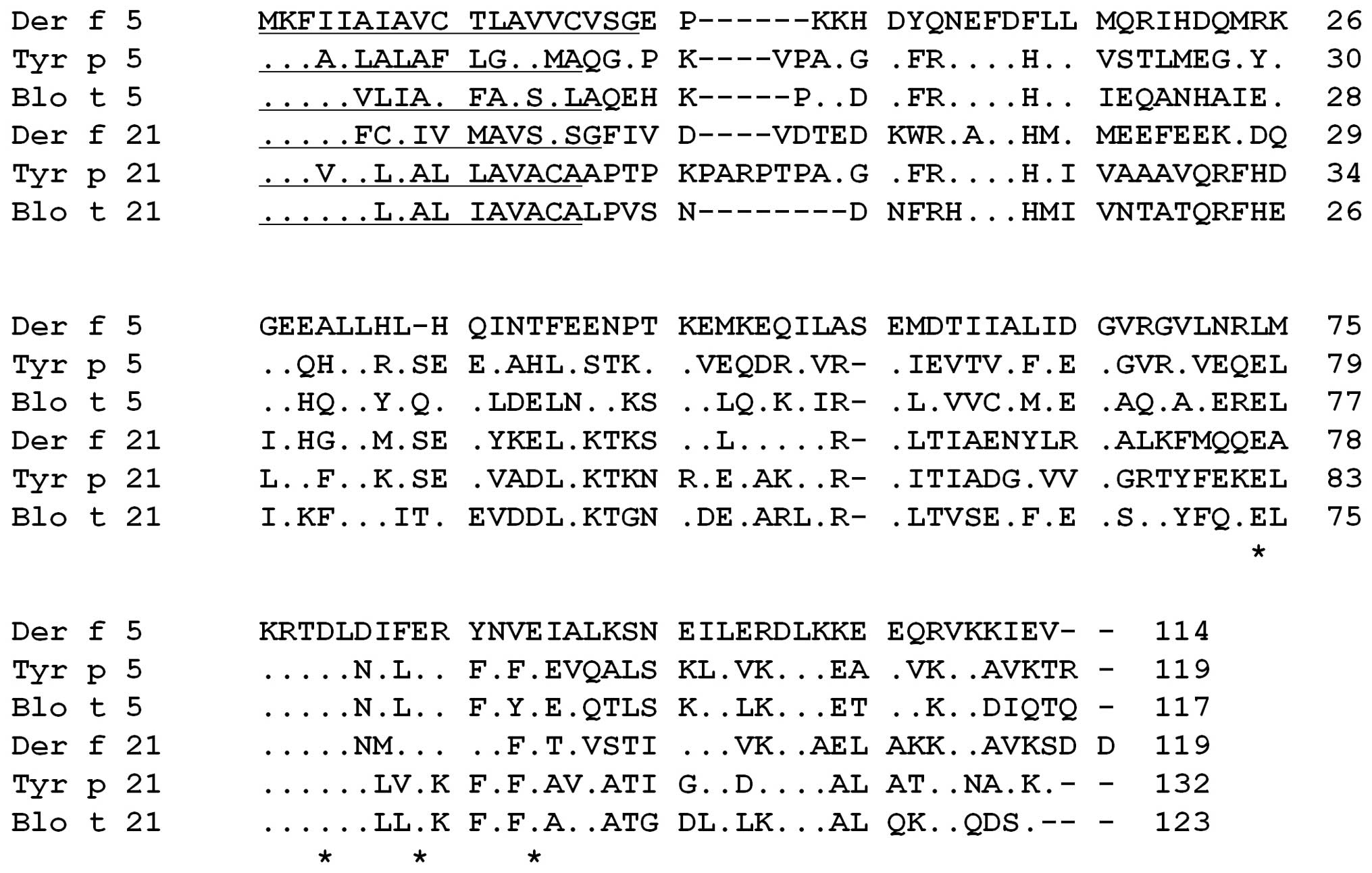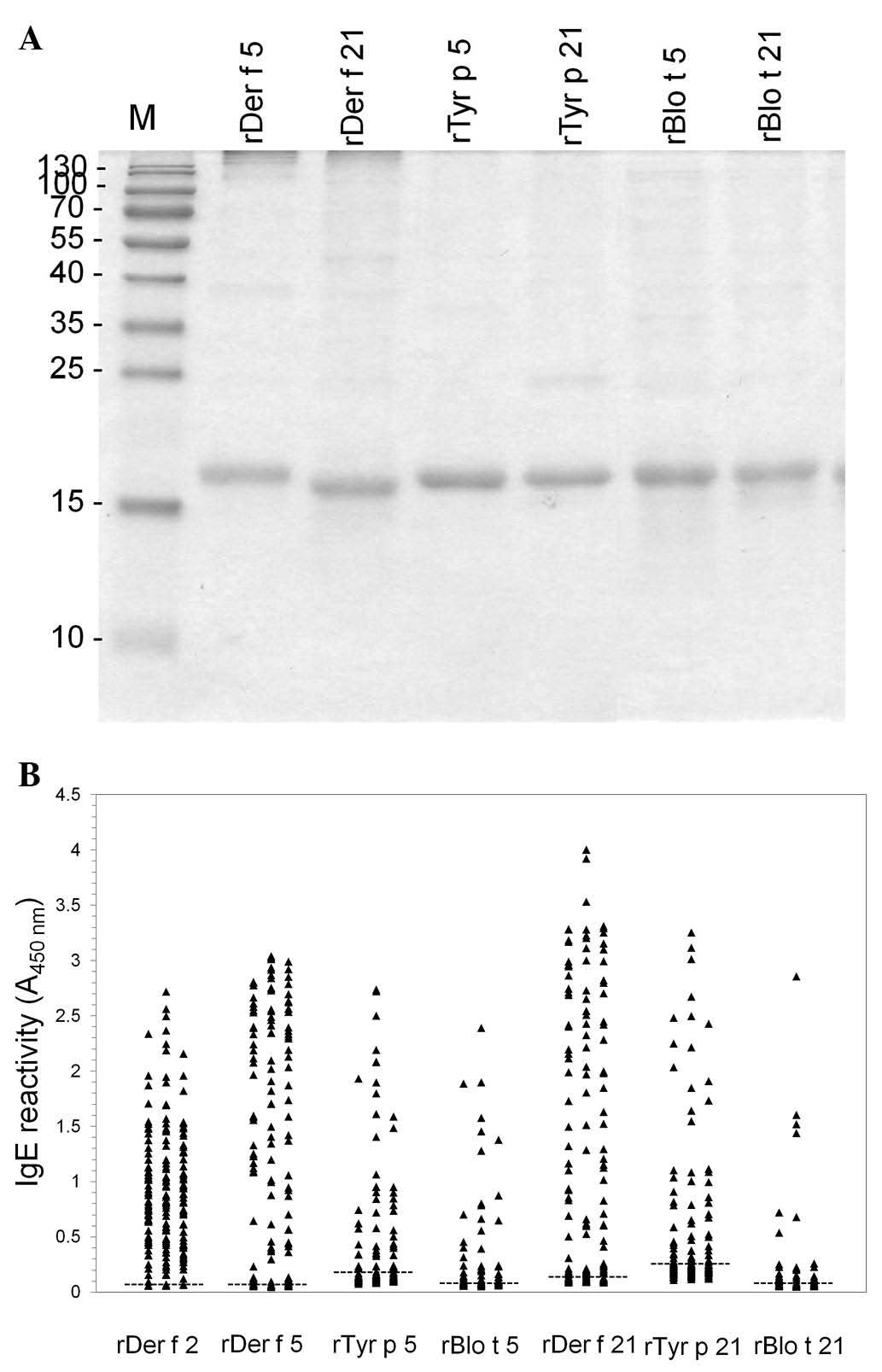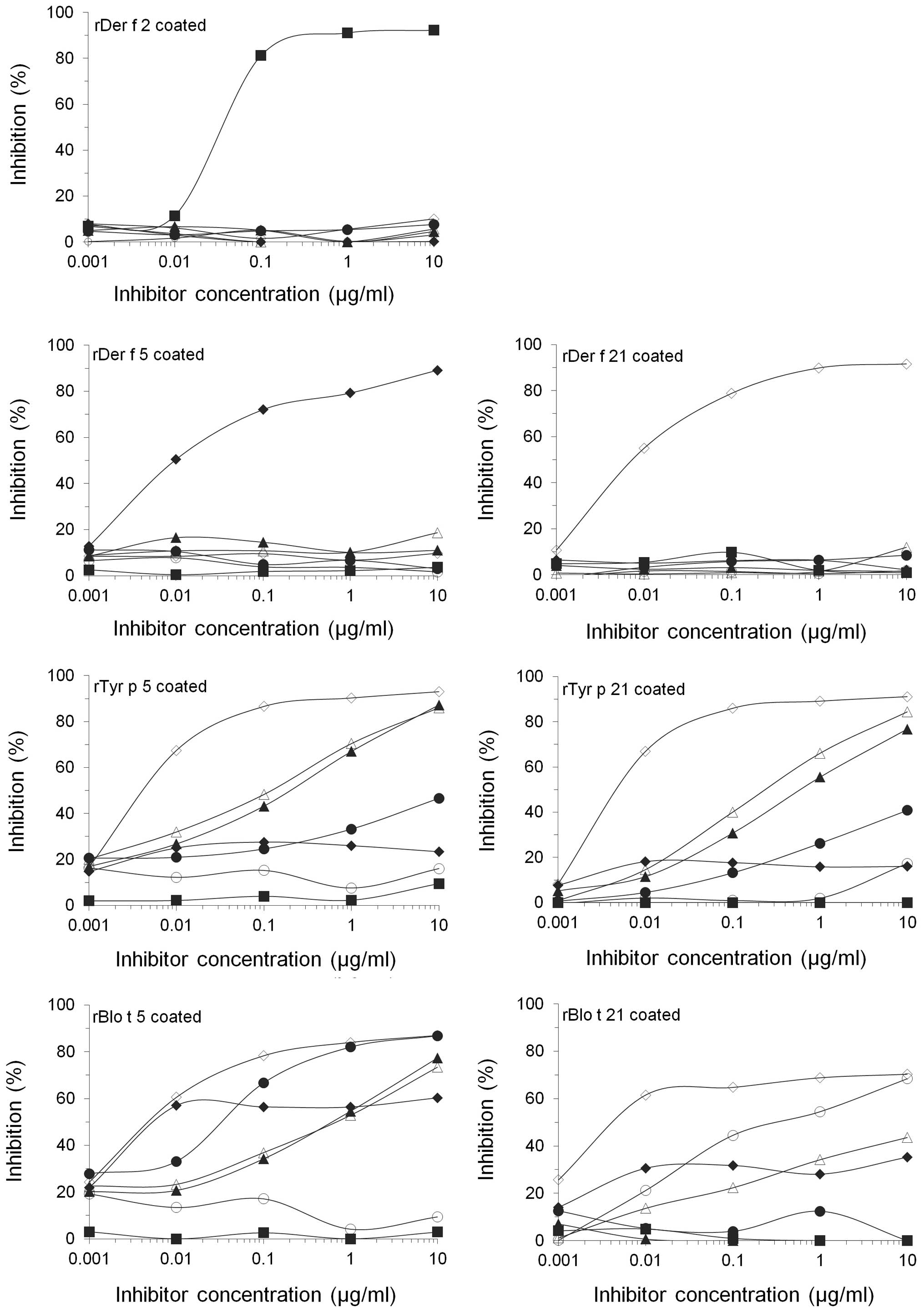|
1
|
Thomas WR, Hales BJ and Smith WA: House
dust mite allergens in asthma and allergy. Trends Mol Med.
16:321–328. 2010. View Article : Google Scholar : PubMed/NCBI
|
|
2
|
Jeong KY, Park JW and Hong CS: House dust
mite allergy in Korea: The most important inhalant allergen in
current and future. Allergy Asthma Immunol Res. 4:313–325. 2012.
View Article : Google Scholar : PubMed/NCBI
|
|
3
|
Yong TS and Jeong KY: Household arthropod
allergens in Korea. Korean J Parasitol. 47(Suppl 47): S143–S153.
2009. View Article : Google Scholar : PubMed/NCBI
|
|
4
|
Bessot JC and Pauli G: Mite allergens: An
overview. Eur Ann Allergy Clin Immunol. 43:141–156. 2011.PubMed/NCBI
|
|
5
|
Reese G, Ayuso R and Lehrer SB:
Tropomyosin: An invertebrate pan-allergen. Int Arch Allergy
Immunol. 119:247–258. 1999. View Article : Google Scholar : PubMed/NCBI
|
|
6
|
Jeong KY, Hong CS and Yong TS: Allergenic
tropomyosins and their cross-reactivities. Protein Pept Lett.
13:835–845. 2006. View Article : Google Scholar : PubMed/NCBI
|
|
7
|
Gámez C, Sánchez-García S, Ibáñez MD,
López R, Aguado E, López E, Sastre B, Sastre J and del Pozo V:
Tropomyosin IgE-positive results are a good predictor of shrimp
allergy. Allergy. 66:1375–1383. 2011. View Article : Google Scholar : PubMed/NCBI
|
|
8
|
Nieuwenhuizen NE and Lopata AL: Anisakis:
A food-borne parasite that triggers allergic host defences. Int J
Parasitol. 43:1047–1057. 2013. View Article : Google Scholar : PubMed/NCBI
|
|
9
|
Acevedo N and Caraballo L: IgE
cross-reactivity between Ascaris lumbricoides and mite allergens:
Possible influences on allergic sensitization and asthma. Parasite
Immunol. 33:309–321. 2011. View Article : Google Scholar : PubMed/NCBI
|
|
10
|
Huang CH, Liew LM, Mah KW, Kuo IC, Lee BW
and Chua KY: Characterization of glutathione S-transferase from
dust mite, Der p 8 and its immunoglobulin Ecross-reactivity with
cockroach glutathione S-transferase. Clin Exp Allergy. 36:369–376.
2006. View Article : Google Scholar : PubMed/NCBI
|
|
11
|
Liao EC, Lin YH, Chiu CL, Lin TC and Tsai
JJ: Identification of allergeniccomponent Tyr p 8 from Tyrophagus
putrescentiae and cross-reactivity with Der p 8. Clin Vaccine
Immunol. 20:506–512. 2013. View Article : Google Scholar : PubMed/NCBI
|
|
12
|
Johannessen BR, Skov LK, Kastrup JS,
Kristensen O, Bolwig C, Larsen JN, Spangfort M, Lund K and Gajhede
M: Structure of the house dust mite allergen Der f 2: Implications
for function and molecular basis of IgE cross-reactivity. FEBS
Lett. 579:1208–1212. 2005. View Article : Google Scholar : PubMed/NCBI
|
|
13
|
Barber D, Arias J, Boquete M, Cardona V,
Carrillo T, Gala G, Gamboa P, García-Robaina JC, Hernández D, Sanz
ML, et al: Analysis of mite allergic patients in a diverse
territory by improved diagnostic tools. Clin Exp Allergy.
42:1129–1138. 2012. View Article : Google Scholar : PubMed/NCBI
|
|
14
|
Park JW, Ko SH, Yong TS, Ree HI, Jeoung BJ
and Hong CS: Cross-reactivity of Tyrophagus putrescentiae with
Dermatophagoides farinae and Dermatophagoides pteronyssinus in
urban areas. Ann Allergy Asthma Immunol. 83:533–539. 1999.
View Article : Google Scholar
|
|
15
|
Son M, Jeong KY, Kim BJ, Lim KJ, Lee JH
and Park JW: IgE reactivity to Acarus siro extract in Korean dust
mite allergic patient. Exp Appl Acarol. 63:57–64. 2014. View Article : Google Scholar
|
|
16
|
Jeong KY, Kim CR, Un S, Yi MH, Lee IY,
Park JW, Hong CS and Yong TS: Allergenicity of recombinant troponin
C from Tyrophagus putrescentiae. Int Arch Allergy Immunol.
151:207–213. 2010. View Article : Google Scholar
|
|
17
|
Fernández-Caldas E, Iraola V and Carnés J:
Molecular and biochemical properties of storage mites (except
Blomia species). Protein Pept Lett. 14:954–959. 2007. View Article : Google Scholar
|
|
18
|
Lin KL, Hsieh KH, Thomas WR, Chiang BL and
Chua KY: Characterization of Der p V allergen, cDNA analysis and
IgE-mediated reactivity to the recombinant protein. J Allergy Clin
Immunol. 94:989–996. 1994. View Article : Google Scholar : PubMed/NCBI
|
|
19
|
Arruda LK, Fernandez-Caldas E, Naspitz CK,
Montealegre F, Vailes LD and Chapman MD: Identification of Blomia
tropicalis allergen Blo t 5 by cDNA cloning. Int Arch Allergy
Immunol. 107:456–457. 1995. View Article : Google Scholar : PubMed/NCBI
|
|
20
|
Kuo IC, Cheong N, Trakultivakorn M, Lee BW
and Chua KY: An extensive study of human IgE cross-reactivity of
Blo t 5 and Der p 5. J Allergy Clin Immunol. 111:603–609. 2003.
View Article : Google Scholar : PubMed/NCBI
|
|
21
|
Gao YF, Wang de Y, Ong TC, Tay SL, Yap KH
and Chew FT: Identification and characterization of a novel
allergen from Blomia tropicalis: Blo t 21. J Allergy Clin Immunol.
120:105–112. 2007. View Article : Google Scholar : PubMed/NCBI
|
|
22
|
Weghofer M, Dall'Antonia Y, Grote M,
Stöcklinger A, Kneidinger M, Balic N, Krauth MT, Fernández-Caldas
E, Thomas WR, van Hage M, et al: Characterization of Der p 21, a
new important allergen derived from the gut of house dust mites.
Allergy. 63:758–767. 2008. View Article : Google Scholar : PubMed/NCBI
|
|
23
|
Weghofer M, Grote M, Dall'Antonia Y,
Fernández-Caldas E, Krauth MT, van Hage M, Horak F, Thomas WR,
Valent P, Keller W, et al: Characterization of folded recombinant
Der p 5, a potential diagnostic marker allergen for house dust mite
allergy. Int Arch Allergy Immunol. 147:101–109. 2008. View Article : Google Scholar : PubMed/NCBI
|
|
24
|
Tan KW, Ong TC, Gao YF, Tiong YS, Wong KN,
Chew FT and Mok YK: NMR structure and IgE epitopes of Blo t 21, a
major dust mite allergen from Blomia tropicalis. J Biol Chem.
287:34776–3485. 2012. View Article : Google Scholar : PubMed/NCBI
|
|
25
|
Cardona G, Guisantes J, Postigo I, Eraso
E, Serna LA and Mar tínez J: Allergenic cross-reactivity between
Blomia tropicalis and Blomia kulagini (Acari: Echymiopodidae)
extracts from optimized mite cultures. J Investig Allergol Clin
Immunol. 15:259–265. 2005.
|
|
26
|
Casset A, Mari A, Purohit A, Resch Y,
Weghofer M, Ferrara R, Thomas WR, Alessandri C, Chen KW, de Blay F,
et al: Varying allergen composition and content affects the in vivo
allergenic activity of commercial Dermatophagoides pteronyssinus
extracts. Int Arch Allergy Immunol. 159:253–262. 2012. View Article : Google Scholar : PubMed/NCBI
|
|
27
|
Vrtala S, Huber H and Thomas WR:
Recombinant house dust mite allergens. Methods. 66:67–74. 2014.
View Article : Google Scholar
|













